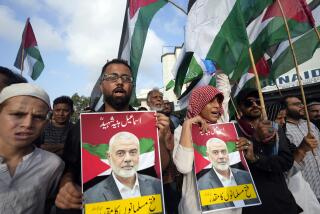Talks Nearly Out of Control in Early Hours
- Share via
PARIS — The standoff over the crippled American spy plane got off to a bad start and almost spiraled out of control during its first 48 hours, U.S. officials said Wednesday.
Tense atmospherics and domestic rivalries in China contributed to a crisis that took nine more days--and a diplomatic rescue effort--to resolve, according to U.S. officials involved in the episode.
The aftermath of the April 1 midair collision between a U.S. Navy EP-3 surveillance plane and a Chinese F-8 fighter jet over the South China Sea quickly became confrontational, partly because of timing.
The United States quickly became aware that its crippled spy plane had found it necessary to land on Hainan island on Sunday, a day when China’s government bureaucracy essentially closes down, U.S. officials said.
It took almost half a day for U.S. Ambassador Joseph W. Prueher to find someone he could talk to at the Foreign Ministry in Beijing about the 24 American crew members who were stranded 1,450 miles south of the Chinese capital.
In the meantime, local officials and People’s Liberation Army commanders on Hainan had taken control of the crew. The rivalry between the central government and the army is a divisive aspect of Chinese politics, and it immediately complicated the rescue effort.
The problems that U.S. diplomats encountered as they tried to gain access to the 21 men and three women held on Hainan were exacerbated by the apparent death of the F-8 fighter pilot and China’s historic resentment of foreign meddling.
That fear of foreign intervention, plus China’s nationalist pride, its claim to global importance and its long-standing anger over American surveillance operations crystallized into Beijing’s demand for an official U.S. apology.
During the crucial first two days of the crisis, frustration was clearly mounting in Washington. On Monday, April 2, President Bush spoke out. “Our priorities are the prompt and safe return of the crew and the return of the aircraft without further damaging or tampering,” he said. “The first step should be immediate access by our embassy personnel to our crew members.”
By that Tuesday, April 3, frustration had escalated into anger. “It is time for our service men and women to return home,” he said bluntly. “It is time for the Chinese government to return our plane.”
Looking back, U.S. officials acknowledge that their singular focus on the American crew members may have struck the wrong note with Beijing by not acknowledging the loss of Chinese life.
A key turning point came April 4, when Prueher and his team of diplomats took charge of the negotiations. They toned down the administration’s demands and tried to construct a formula that would allow both sides to save face.
“Almost all credit for the diplomacy, for crafting the right words, for all the various efforts to get this resolution, goes to Prueher and his team in Beijing. They were the people doing all the hard work, with [Secretary of State Colin L.] Powell and [Deputy Secretary of State Richard L.] Armitage here making the final decisions,” said a senior U.S. official, who, like others interviewed for this report, asked to remain anonymous to avoid violating government regulations.
By that Wednesday, the United States had laid out a “road map” to resolve the crisis, and Powell became the first U.S. official to publicly express regret for the incident. The standoff then settled into a pattern of sporadic talks.
The diplomacy reflects the style of the new secretary of State. On his first day in office, Powell promised his staff that he would rely more heavily on career Foreign Service officers to carry out U.S. diplomacy. And during the Bush administration’s first foreign policy crisis, that’s exactly what he did, U.S. officials said.
During the Clinton administration, the president and his team of top advisors tended to micromanage many crises. But Powell and Armitage listened to the advice offered by Prueher in a daily series of calls that lasted late into the night.
Armitage worked on the details, and Powell made the big decisions, U.S. officials said.
By Friday, the language needed to end the standoff was in place and had undergone only minor “fiddling” since, officials said.
But it took five more days to convince the Chinese that the terms offered by the United States were all they were going to get, U.S. officials said. The deal may have been clinched by a well-choreographed set of television appearances by Bush administration officials who publicly expressed their sorrow over the loss of China’s pilot.
Beijing could finally claim that it had received the apology it was demanding, while the United States could claim that it had expressed sorrow only for the loss of life and for the technical failure to receive permission to land its spy plane in China.
More to Read
Sign up for Essential California
The most important California stories and recommendations in your inbox every morning.
You may occasionally receive promotional content from the Los Angeles Times.













